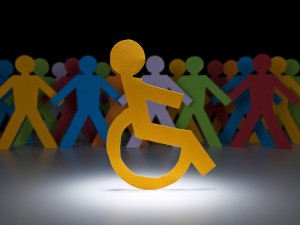
In the UK over 10 million people live with a disability, many of whom suffer from violence (Department for Working Pensions, 2011). A recent World Report on Disability by WHO (2011) highlighted that people living with disabilities are at risk from sexual and physical violence.
Despite this, little is known about who is at risk of violence, what the consequences of this violence are, and the types of violence they suffer (Hughes, 2012). This information is important for a number of reasons, not least because it could be used to increase the detection and reduction of violence. For these reasons a new study based on the British Crime Survey (BCS) has begun to address some of these questions (Khalifeh, 2013).
The researchers asked:

Are people with disabilities at greater risk of violence than those without a disability?
- Are people with disabilities at greater risk of violence than those without a disability, and do people with mental illness have a greater risk than those with other disabilities?
- Do disabled victims experience more severe health problems following violence than non-disabled victims?
- What proportion of violence victimisation in the population as a whole (and in those with disability) is attributed to the independent presence of a disability, and what are the economic costs of this?
Methods
The study analysed data collected from the 2009/2010 British crime survey (BCS). The BCS is a nationally representative cross-sectional survey of crime victimisation in men and women aged 16 or over living in private residential households in England and Wales. The survey is conducted by lay interviewees who use door to door visits to interview people, including measures of non-domestic and domestic physical and sexual violence. Sexual assaults are measured using a more sensitive questionnaire, but only on those aged between 16-60.
99.5% of BCS respondents were included in the analysis; 9,037 of people reported a disability. Disability was defined as: “A long standing physical or mental health condition that has lasted or is expected to last 12 months or more and which limits day to day activities”.
The sub-types of disabilities reported included: long-term physical illness, learning disability, mental health conditions and mobility and sensory impairments.
The researchers conducted a multivariate logistic regression. One analysis was carried out on the whole data and a separate analysis was carried out on the self-completion questionnaire on sexual violence.
Results

Disabled people were more likely to experience mental health problems following violence, especially those with pre-existing mental illness
- They found a clear association between disability and both physical and sexual assaults. With a higher risk of violence among those with mental illness that any of the other subtypes of disability
- Domestic violence was reported around 7% more in disabled versus non-disabled victims, with 8% fewer reports of non-domestic violence by disabled victims
- Those with one or more disabilities were more likely to be a victim of violence in the past year when compared with the non-disabled population
- Overall, disabled people were more likely to experience mental health problems following violence, especially those with pre-existing mental illness
Conclusions
The authors concluded:
People with disability are at increased risk of being victims of domestic and non-domestic violence, and of suffering mental ill health when victimized. The related public health and economic burden calls for an urgent assessment of the causes of this violence, and national policies on violence prevention in this vulnerable group.
The authors also note that the research highlights the need for clinicians to be aware of elevated risk violence among patients with all types of disabilities, and that clinicians should consider explicitly screening for violence and its effects. It was estimated that in England in 2009, 116,000 disabled victims may have experienced violence because they had a disability, which cost around £1.51 billion.
Whilst this is a large nationally representative sample, the authors caution that it did not include people living in residential supported accommodation and that there is possible reporting and disclosure bias because of fear of reporting, and/or because some disabilities could make filling out interviews and questionnaires difficult. This means that the findings may under-represent the experiences of violence in these groups. Nevertheless, this study is an important step forward in understanding the violence against those living with disabilities in the UK.
This blog by Michael Walton originally appeared on the Mental Elf on 12th March 2013: http://www.thementalelf.net/publication-types/survey/people-with-disability-are-more-likely-to-be-victims-of-violence-and-to-suffer-mental-illness-as-a-result/
Links
Khalifeh H, Howard LM, Osborn D, Moran P, Johnson S. Violence against People with Disability in England and Wales: Findings from a National Cross-Sectional Survey. PLoS ONE 2013; 8(2): e55952. doi:10.1371/journal.pone.0055952
World Report on Disability. World Health Organization, 2011.
Hughes K, Bellis MA, Jones L, Wood S, Bates G, et al. Prevalence and risk of violence against adults with disabilities: a systematic review and meta-analysis of observational studies (PDF). The Lancet 2012; 379: 1621–1629.
Family Resources Survey: United Kingdom 2009–2010 (PDF). Department for Works and Pension, 2011.

Mr. Tomlin, thanks for writing this article. There
are many children, from a very young age, with learning
disabilities due to severe violence in the home. I am one
of them. I’m an adult now that still has difficulty learning because of it, but I have been able to learn somehow.
I will follow your blog. Frank in Florida.
Hi Frank. Thank you for your comment on the blog post and for sharing your experience.
Your comment made me think again about the confusion that is sometimes caused by the term ‘learning disabilities’ between readers in the UK and readers in the USA.
There is a difference in the way the term ‘learning disability’ is used in the UK and the US.
In the UK, learning disability refers to
“significantly reduced ability to understand new or complex information, to learn new skills
reduced ability to cope independently which starts before adulthood with lasting effects on development.”
A learning disability occurs when the brain is still developing – before, during or soon after birth.
Before birth things can happen to the central nervous system (the brain and spinal cord) that can cause a learning disability.
There are also genetic causes, for example those that result in Down syndrome
After birth, a learning disability can be caused by early childhood illnesses.
In the USA ‘learning disability’ usually refers to what in the UK, we would call specific learning difficulties, such as auditory processing disorder, dyslexia, dyscalculia etc.
Internationally, we are beginning to see the term ‘intellectual disabilities’ used for what the UK calls learning disabilities.
best wishes
John